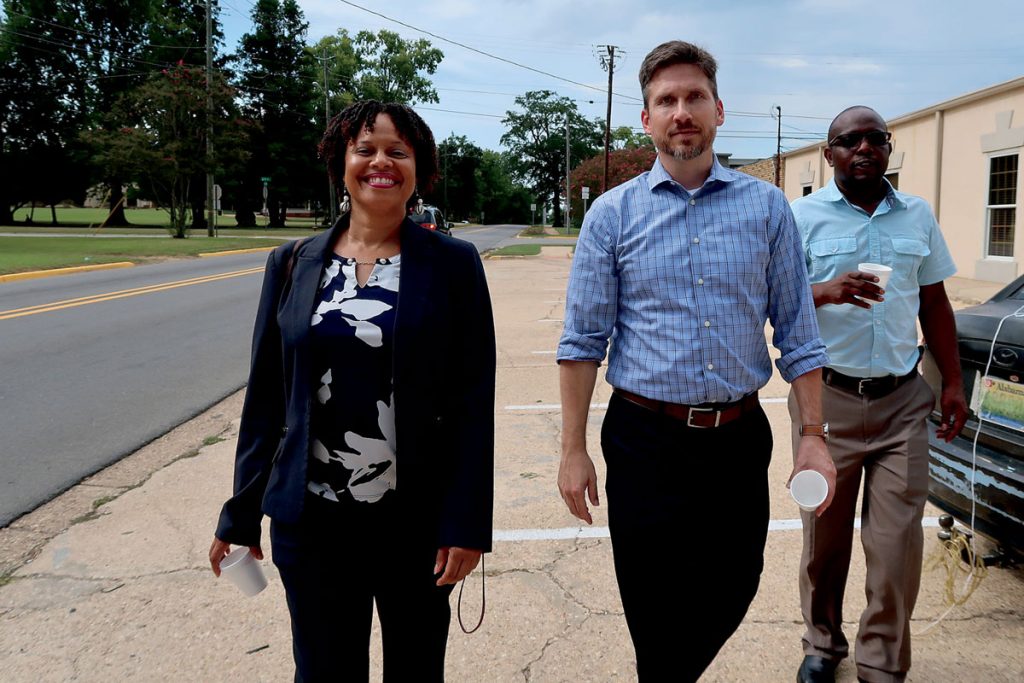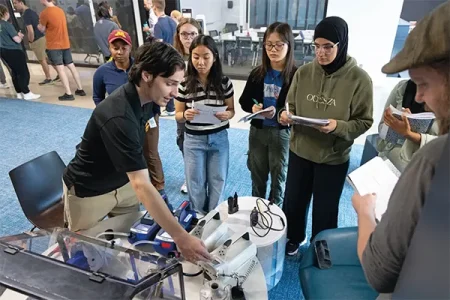
For Billy Kirkpatrick, questions around how people with HIV/AIDS can receive the best care weigh heavily on his mind. As chief executive officer of Five Horizons Health Services in Tuscaloosa, AL, he provides services such as finding affordable housing and transportation for those with HIV/AIDS. But how does this work help people live with the disease in a region where the death rate for HIV-positive individuals is higher than any other in the U.S.?
To find answers to his questions, Kirkpatrick teamed up with researchers Safiya George, assistant dean for research and associate professor at the University of Alabama Capstone College of Nursing, and G. Tongi Mugoya, associate professor of rehabilitation at the University of Alabama College of Education.
The three are fellows in a program called Interdisciplinary Research Leaders (IRL) at the School of Public Health. Funded by the Robert Wood Johnson Foundation (RWJF), IRL is building an innovative approach to research where two academic researchers from different fields and a community leader join forces as equal partners to tackle issues vital to communities. The program annually funds 15 teams for three years each. Each member receives equal funding and equal participation in the team experience and curriculum. Through their work, and along with the communities that shape their research, the teams strive to produce action-oriented, community-engaged research to help build a national culture of health where everyone has the opportunity to live a healthier life. It is the mission of RWJF.
IRL focuses on two key elements to help the teams build that culture of health: Grow their skills in designing, implementing, and translating research into action and engage communities to change policy. “There is a lot of research that provides evidence to move communities toward better health, but with IRL, we wanted to ensure research was focused in the right way to be useful and that it gets into the hands of the right people,” says Nancy Fishman, IRL senior program officer at RWJF.
Home in Minnesota
Schools of public health around the country applied to be home to IRL. Minnesota’s proposal had Professor Michael Oakes as co-director alongside Jan Malcolm, who was vice president of public affairs and philanthropy at Allina Health and is now commissioner of the Minnesota Department of Health. SPH health policy faculty members Sarah Gollust, Ezra Golberstein, and Kathleen Call rounded out the UMN team.
As community lead, Malcolm recruited Local Initiatives Support Corporation and ISAIAH (a state-wide coalition of faith communities fighting for racial and economic justice) as partners. “I knew these organizations completely understood the connection between health and community engagement at the deepest level,” says Malcolm.
“Minnesota had the right people at the table,” says Fishman. “They had a strong academic team, and the combination of community partners involved in the proposal showed us that they understood the importance of the community perspective.”
RWJF chose Minnesota and in September 2016, IRL welcomed its first cohort of 15 teams, including Kirkpatrick, George, and Mugoya.
The IRL Way
Now in its third year, the program is changing the game for fellows with a method Oakes calls the “IRL way.”
“In academia, we often develop ideas, do the research, and then let the findings disseminate on their own. Rarely does our work get outside of academic circles,” says Oakes, who is also associate vice president for research at the University of Minnesota.
Michael Oakes
Instead, the IRL way encourages interdisciplinary collaboration, working closely with the community, and ensuring research can be put into action. “IRL fellows partner with the people they aim to help and get a rich understanding of that community,” says Oakes. “This makes research questions better and study findings easier for communities to put into action.”
“We’re setting the stage for the people who are most affected to be involved in a hands-on way with the research and implementation of the research,” says Paul Marincel, who leads strategic initiatives at ISAIAH and has been involved in IRL since its start.
The IRL way encourages research that creates change fast. According to Oakes, researchers outside IRL currently operate on the assumption that if a community or policymaker has the information, they’ll use it. But, for Oakes and RWJF, that model is too passive. IRL fellows begin by asking communities what information they need and how they would use it, says Oakes.
Creating Change Through Leadership
IRL fellows go through rigorous training in research leadership. Their curriculum spans team building, research development, design, dissemination, and how to translate research into action. By building leadership skills, IRL encourages fellows to be more assertive and take their work a step further. “We’re building tools for fellows so they have support in elevating their work,” says Gollust.
For George, the lessons learned through IRL changed her view of how her work can be effective. “I now have the skills to present evidence in a useful way so that we can translate findings into practice for policymakers,” she says.
In addition to research-related curriculum, IRL training also teaches fellows how to organize communities and use grassroots movements to create policy change. “When it comes to addressing social determinants of health, there is a relatively small group of people who have the power to make decisions,” says Marincel. “With IRL, we’re making that group larger by equipping fellows with the power and the tools to make change.”
And fellows who are faculty members are passing what they learn on to their students. “With my students, I’m talking with more conviction about community partnership and have real examples of what this actually means and the role the community can play in shaping research,” says Mugoya. “I tell them, yes, you can gather the data and do the research, but you have to think about who will benefit from the information and how you’re going to not only publish results, but also help make sure those results reach the right people.”

The Model
Across the U.S., communities face great challenges when it comes to health and well-being. To give everyone the chance for a healthy life will take forging new relationships between researchers and communities. The IRL team model brings together two researchers from different academic fields into equal partnership with a community leader and the team tackles issues that the community defines. By stepping out of the traditional research model, the team and the community can move findings quickly into acton.
The Impact
This collaboration model has implications for the public health workforce. “At the Minnesota Department of Health, we’re working to get community groups around the state engaged in questions about what really produces health and how we can change conditions,” says Malcolm. “By implementing the IRL model we can make a stronger link between research, the community, and public health workforce development.”
Oakes believes that the IRL program is having a meaningful impact on all states and their universities: “Evolving our research in this way is a critical piece for universities, and for faculty staying relevant and fulfilling our mission to serve the public’s health.”


